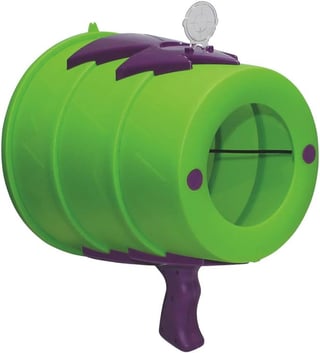Tl/Dr: It takes a lot to plow through space like you want. Far more than is reasonable via rail-gun CME.
Railguns do actually demonstrate a mass ejection when they fire. The plasma which is accelerating the round escapes the barrel at the end of the shot. However, it will be hard to make it do what you want. Coronal Mass Ejections are impressive because they are big and lots of energy gets released. However, when you really get down to it, they're really nothing more than really fast puffs of air. Well, plasma really, but basically air.
How accurately are you tracking objects? From your description of a "plow," it looks like you're seeking a brute force solution. If you were tracking each particle independently, and burping a small mass ejection directly at it, this might lead to a different problem.
Combine these two, and we see the dilemma begin to emerge. The closer a particle is to the ship when it is affected by the CME, the faster it needs to be moved out of the way, requiring more momentum transfer. Increased momentum transfer requires higher speeds or more mass ejected. If we've fixed the speed at CME speeds, the only option left is to simply eject more mass. We know what we call a component that ejects a large amount of mass at high speed to transfer momentum. It's called a rocket engine. You're looking to mount a very large retro-rocket on the front of your craft. Which means that you also have to have a corresponding rocket firing rear-wards, with at least the same thrust, or you will slow down.
How much? Let's say we want to move our pebble away in 1s, and the spacecraft is 100m in diameter. We need an acceleration of $200\frac{m}{s^2}$ (from $x=\frac 1 2 at^2 + x_0$). Maybe the pebble is 0.05kg, so we need a force of 10N on this pebble. Assume the pebble is 10mm in diameter*, so $0.0001 m^2$. This means we need a pressure of $100000\frac{N}{m^2}$. For those of us who use English units, that's around 14 psi... and regardless of where you live, that's about 1 standard atmosphere!
And that takes a lot of mass. We can calculate how much by looking at stagnation pressure: $P_1=P_2+\frac 1 2 \rho v^2$. In our case, $P_2$ is 0 (vacuum), so we only have to consider $\frac 1 2 \rho v^2$. CMEs are predicted to travel at around 450km/s, giving us a density($\rho$) of $10\frac{mg}{m^3}$. If I may arbitrarially pick a 100m diameter ship (call it $10000\text m^2$ for simplicity), we find we need a linear density of $0.0098\frac{kg}{m}$, and at the CME speeds, that's $4444\frac{kg}{s}$. Round it up to $5000\frac{kg}{s}$ for simplicity. For perspective, a Falcon 9 rocket emits $2100\frac{kg}{s}$ during launch, so your ship traveling at ludicrist speeds is emitting the mass of two Falcon 9 rockets, constantly. And it's doing it at much higher exhaust velocities. The exhaust velocity of a Falcon 9 is around 3km/s. We're emitting at 450km/s, so the energy requirements are much higher: about 20,000 times more energy.
What about affecting the particles further away? The further away one affects the particles, the less acceleration and less momentum you need. This is proportional to the square of the distance. If your influenced space-pebble has twice the time to get out of the way, it can get out of the way with one-fourth of the force. This is good, but leads to another dilemma. If you were clearing out the space directly in front of the ship, you only need to plow a ship-sized hole through space. But the further away your effects occur, the more we realize we can't just consider relative positions. We also need to consider relative velocities. Micrometerorites are traveling at speeds measured in km/s with respect to, say, the sun. If you push objects out of your way over the course of 100s, the spatial range of objects to consider is now 100s times, say, 10 km/s*, or a 1,000 km sphere. You have to fill this sphere with CME ejections.
As you can see, efficiency is going to be painful here. We have a continuous CME, so we only need to consider the cross sections. We have a cross section of $1,000,000 \text{km}^2$ to strike a pebble that might be 10mm across - a cross section of $0.0000000001 \text{km}^2$. Efficiency here is obviously limited to 0.00000000000001%. We can repeat the calculations above, with $t=100s$ instead of $t=1s$ and a plow cross section of $1,000,000 \text{km}^2$, to get a number that's 10000x worse. It takes 20000 Falcon 9's worth of exhaust flow rate at 450km/s to fill that gargantuan space.!
What this tells me is that CMEs from railguns is a very ineffective way to clear a path in front of your spacecraft. Now you haven't specified "Ludacris Speeds" so we don't know what sorts of energies are available on this ship, but I think its clear that basically any specialized tool for clearing the path ahead will be so unimaginably more efficient than railgun CMEs that it will almost certainly earn its mass and power budget abord the ship.
What you probably need is a targeting system that identifies candidates to move out of the way, and a more focused approach. Perhaps strike the object with a railgun round. Or use lasers to ablate one side and push it out of the way.
Or if you really want to use plasma, you need to contain it into a focused blast. You need a self-propagating vortex of plasma. Maybe something like this:

*. Chosen to match micrometeoroids in Earth orbit. This is just to anchor the numbers to something. It's back of the envelope

